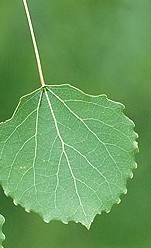 Shakespeare’s aspen was probably Populus tremula a native of the cool areas of Europe, Asia and North Africa and should not be confused with the aspen of North America, Populus tremuloides, although both go by the common name quaking aspen. Populus tremula is a deciduous tree that grows quickly to over sixty feet. Its mature leaves are nearly round and have toothed margins and flat petioles that allow the leaves to tremble in the slightest breeze. Male and female catkins are produced in late winter to early spring on different trees before the leaves appear and give way to ten to twenty capsules in early summer containing numerous seeds enveloped in cottony fluff that aids in wind seed dispersal.
Shakespeare’s aspen was probably Populus tremula a native of the cool areas of Europe, Asia and North Africa and should not be confused with the aspen of North America, Populus tremuloides, although both go by the common name quaking aspen. Populus tremula is a deciduous tree that grows quickly to over sixty feet. Its mature leaves are nearly round and have toothed margins and flat petioles that allow the leaves to tremble in the slightest breeze. Male and female catkins are produced in late winter to early spring on different trees before the leaves appear and give way to ten to twenty capsules in early summer containing numerous seeds enveloped in cottony fluff that aids in wind seed dispersal.
Shakespeare mentions the aspen in two plays. In Titus Andronicus (act ii, sc 4, 44) Marcus, the Tribune of the People and brother of Titus Andronicus says to his niece, Lavinia who has just been raped and disfigured;
O, had the monster seen those lily hands
Tremble, like Aspen leaves, upon the lute,
And make the silken strings delight to kiss them,
He would not then have touch’d them for his life!
In 2nd Henry IV (act ii, sc. 4, 114) Mistress Quickly, the hostess and proprietor of the seedy Boar’s Head Tavern in Eastcheap, London, talks to crooked John Falstaff, mentor and close friend of Prince Hal, and his favorite prostitute Doll Tearsheet;
Feel, masters, how I shake….Yea, in very truth do I an’twere an Aspen leaf. I cannot abide swaggerers.
Poplars were known in ancient times and both the Greeks and Etruscans made shields from their wood. The ancient Roman, Pliny recommends poplar for this use and the people of the Middle Ages continued the practice. The English botanist and herbalist Gerard, contemporary of Shakespeare, mentions the relationship of the wagging tongues of women and the trembling nature of the aspen leaf in his herbal.